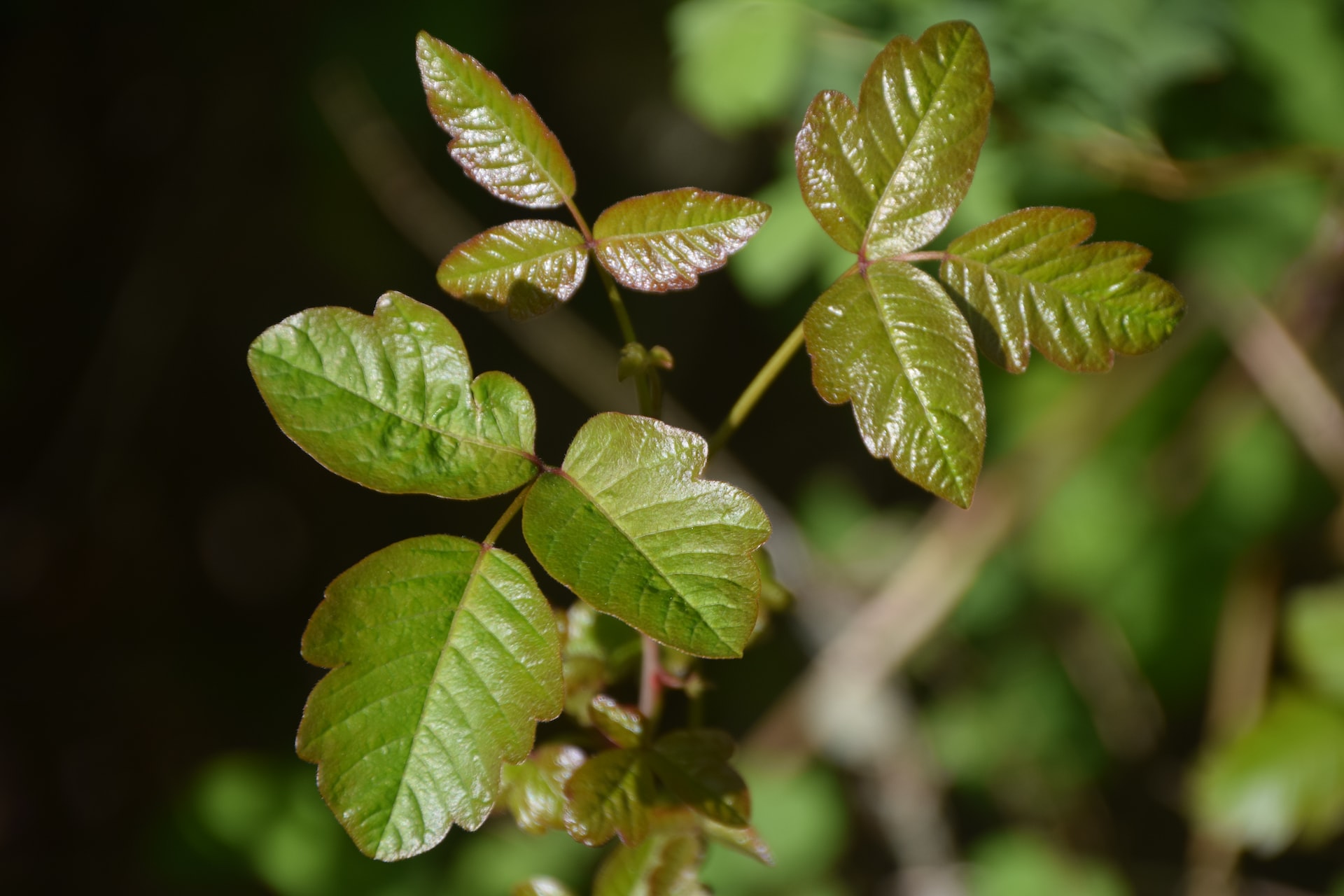
11 Outdoor-Related Rashes
We are reader-supported. When you buy through links on our site, we may earn affiliate commission.
It’s an all-too-familiar experience: You go for a day hike with high hopes and a picnic basket, and head home with a mysterious rash. Where could it possibly have come from? Here are some outdoor irritants that could be responsible and some rashes that come from nature (and beyond).
- Poison Oak (Toxicodendron pubescens)
This upright shrub is native to North America and has the following characteristics:
- Alternate leaves with three leaflets: You may have heard the adage, “Leaves of three, let it be.” This warning applies to poison oak and poison ivy. The leaves are green to red depending on the season.
- White flowers: It has tiny white clusters of blooms in the spring.
- Urushiol: This is the poison responsible for the itchy, blistering rash you get from touching the plant.
- Tree of Heaven (Ailanthus altissima)
With a name like that, you’d expect a fragrant, beautiful plant. Guess again! This deciduous tree is an invasive species and has the following traits:
- Large, pinnately compound leaves: They start out as a bronze color, then deepen to a dark green as they mature.
- Two sexes: Tree of heaven is dioecious, meaning there are male and female plants. If you can’t identify the male trees by sight, you’ll know them by their noxious smell, like a cross between a skunk and moldy water.
- Irritating sap: The sap can cause contact dermatitis and potentially even myocarditis, an inflammation of the heart.
- Poison Ivy (Multiple Toxicodendron Species)
This plant causes one of the most infamous rashes that come from nature. Its creeping vines grow low to the ground or climb tree trunks. Identify it by the following:
- Alternate leaves with three leaflets: Like poison oak, it has “leaves of three” to warn you to let it be! The leaves can be green or red depending on the season.
- White flowers: These minuscule flowers develop into white berries.
- Urushiol: Also found in poison oak and poison sumac, this is the toxin responsible for the itchy, blistering rash you get from touching the plant.
- Stinging Nettle (Urtica dioica)
Ouch! You’ll notice this plant as soon as you come in contact with it. As its name suggests, stinging nettle causes a burning sensation similar to fire ant bites. Identify it by these traits:
- Soft green leaves: They grow opposite each other on a hairy stem.
- Two sexes: Female plants have green and white flowers. Males have purple or yellow blooms.
- Prickly hairs: The tips break off when touched, injecting an irritant into your skin.
- Poison Sumac (Toxicodendron vernix)
This woody shrub can grow to the size of a small tree. It has the following physical traits:
- Pinnate leaves: With 7-30 leaflets on each compound leaf, this cousin of poison ivy and poison oak breaks the “leaves of three” rule.
- Green flowers: These tiny flower clusters become greyish-white berries.
- Urushiol: Also found in poison oak and poison ivy, this is the toxin responsible for the itchy, blistering rash you get from touching the plant.
- Plumbago (Plumbago auriculata)
A flowering plant commonly found in gardens, plumbago – also called leadwort – causes skin reactions in some unlucky people who have an allergy to it. Identify it by:
- Simple, entire leaves: They’re arranged in a spiral around the stem and are light green.
- Various flower colors: The clusters of blooms can be blue, purple, pink, white, or red.
- Widespread irritants: Contact with any part of the plant except the flowers can cause a rash or blisters. Then again, many people have no reaction to it!
- Ragweed (Multiple Ambrosia Species)
You’re probably familiar with this one! One of the most common causes of hay fever (another name for seasonal allergies), ragweed causes many people to itch. This plant is characterized by:
- Multiple types of leaves: They can be smooth or hairy, arranged oppositely, alternately, or both, and are divided into lobes. They’re a medium shade of green.
- Both sexes on one flower: Ragweed is monoecious, with fluffy yellow sprays of flowers possessing stamens and pistils.
- Irritating pollen: This is what causes sneezing, watery eyes, itching, and sometimes a rash.
- Cow Parsnip (Heracleum maximum)
This perennial plant is native to North America, East Asia, and Russia. It can grow up to 10 feet tall and has a thick, hollow stem, as well as the following:
- Very large leaves: They’re up to 16 inches across and divided into three lobes, similar to poison ivy.
- Flat umbels: A group of flowers all originating from the same stem is called an umbel. Cow parsnip is topped by a flat group of white flowers.
- Toxic sap: Interestingly, the sap doesn’t cause a rash until it comes in contact with sunlight, which activates the poison. When it does, the skin blisters into an itchy rash.
Other Types of Rashes
It’s possible that your rash came from something besides a plant. Here are some other common outdoor irritants:
- Sunblock
Some people have an allergic reaction to certain types of sunblock that results in a bumpy rash or mild redness. This is called irritant contact dermatitis (or just contact dermatitis). If this is the case for you, look for a sunscreen that doesn’t contain oxybenzone or benzophenone-3, as these are common irritants.
- Bug Spray
DEET, an active ingredient in many insect repellants, can cause rashes or severe allergic reactions in some people. If it makes you itchy, you can try bug spray alternatives such as essential oils.
Wearing long sleeves also helps keep insects from biting you, and you can even buy a bug-net hat that hangs over your face. It may not be the most fashionable choice of attire, but it works!
- Heat Rash
Rashes that come from nature don’t always involve plants. Heat rash is a skin condition usually triggered during hot and humid days when your sweat glands become blocked. It causes an itchy, bumpy red rash. Wear loose clothing and drink plenty of water to reduce your risk of heat rash, and stay inside if it’s too hot to work outdoors comfortably.
Relieving Rashes That Come From Nature (And Elsewhere)
If you’re having a severe allergic reaction – characterized by facial swelling, difficulty breathing, a fever, or rashes on most of your body – or you’ve had a severe reaction in the past, go to the hospital immediately. It’s better to be safe than sorry.
However, you can treat most mild rashes that come from nature with home remedies. First, wash your skin with soap and water as soon as possible. Avoid scratching the rash.
Apply calamine lotion or hydrocortisone cream and consider taking an oral antihistamine to further reduce itching. Cold compresses can also soothe your irritated skin.
To treat heat rash, rinse off in cool water and let your skin dry thoroughly. Calamine lotion and hydrocortisone cream can help, as can wearing loose clothing and applying a cold compress to the irritated area. Even if you don’t treat it, heat rash usually goes away on its own.
Don’t let the fear of getting a rash keep you from enjoying the outdoors! Although there are several kinds of itch-inducing plants and chemicals, you can take steps – such as wearing long pants and sleeves, finding alternatives to bug spray, and trying different types of sunblock – to keep yourself safe and comfortable.
So, take a hike!
Share on
Like what you read? Join other Environment.co readers!
Get the latest updates on our planet by subscribing to the Environment.co newsletter!
About the author

Steve Russell
Steve is the Managing Editor of Environment.co and regularly contributes articles related to wildlife, biodiversity, and recycling. His passions include wildlife photography and bird watching.





